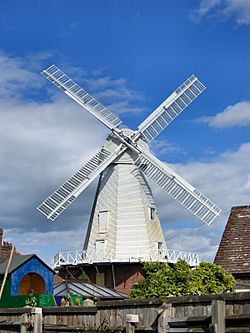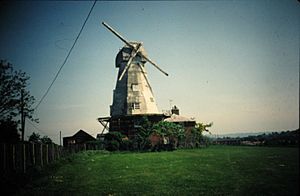New Mill, Willesborough facts for kids
Quick facts for kids New Mill, Willesborough |
|
|---|---|

Willesborough Windmill in 2007
|
|
| Origin | |
| Mill location | Willesborough, Ashford |
| Grid reference | TR 0313 4213 |
| Coordinates | 51°08′32″N 0°54′09″E / 51.14228°N 0.9025°E |
| Operator(s) | Kent County Council |
| Year built | 1869 |
| Information | |
| Purpose | Corn mill |
| Type | Smock mill |
| Storeys | Four-storey smock |
| Base storeys | Two-storey base |
| Smock sides | Eight-sided |
| No. of sails | Four |
| Type of sails | Patent sails |
| Windshaft | Cast iron |
| Winding | Fantail |
| Fantail blades | Eight bladed |
| Auxiliary power | Oil engine |
| No. of pairs of millstones | Four pairs |
The New Mill is a special old windmill located in Willesborough, near Ashford, Kent. It's a type of windmill called a smock mill, and it's considered a very important historical building. Built in 1869, this mill is now a fun museum that you can visit. It stands close to junction 10 of the M20 motorway.
Contents
The Mill's Story: How It Was Built and Used
The New Mill was built in 1869 by a local builder named John Hill. It replaced an older windmill that was there before. Different families worked at the mill over the years. The Cornes family operated it until the First World War. Later, the Manwaring family took over from 1920 until 1938. That was the last time the mill used wind power to grind grain.
After 1938, the mill was sold and used just for storage. Some parts of it were even sold off. For example, its "fantail" (a small windmill at the back that keeps the main sails facing the wind) was moved to another mill in 1946.
Bringing the Mill Back to Life
By 1969, the mill was in very poor condition. However, in 1991, the Ashford Borough Council bought it. They wanted to restore it completely for everyone to enjoy. The mill was carefully repaired and brought back to its original glory.
Today, the mill can make its own stoneground wholemeal bread flour. It uses one set of grinding stones, powered by a special engine. The mill, along with its nearby barn, is a popular place for events. People can hold weddings, Christenings, and other gatherings there.
The mill complex is open to visitors from April to the end of September. You can visit on Saturdays, Sundays, and Bank Holiday Mondays from 2 PM to 5 PM. Schools and other groups can also arrange visits during weekdays.
New Sails and Educational Fun
In 2006, the mill received a special grant from the Heritage Lottery Fund. This money helped replace the mill's large sails. The new sails were put on in April 2007. Part of the grant also helped create an Education pack. This pack is used for school visits to teach kids about windmills.
Now, the windmill is fully working again. It can grind flour using either wind power or its engine. It's also a licensed venue for holding wedding ceremonies.
Norman Museum: Bikes and Mopeds
Norman Cycles was a company that made bicycles, autocycles, mopeds, and motorcycles. Their factory was also in Ashford. The mill's barn complex is now home to the Norman Museum. Here, you can see some of the cool mopeds and bicycles they made. The Norman Cycles Club also has its base at the Windmill.
How the Mill Works: A Closer Look
The New Mill is a four-storey smock mill. It sits on a two-storey brick base. There's also a miller's cottage attached to it. It has four large patent sails that catch the wind. These sails are connected to a strong cast-iron shaft.
The mill uses the wind to power four pairs of millstones. There's also a fifth pair of stones that can be powered by an engine. In the past, this engine was a steam engine, then an oil engine, and later an electric motor. Inside, a large wheel called the Brake Wheel helps turn the machinery. This wheel then turns other gears and shafts that make the millstones spin and grind the grain.
People Who Worked at the Mill
Here are some of the people who worked as millers at New Mill:
- Cornes & Son: 1869 - 1918
- Thomas Sellins: 1869 - 1904
- John Cobb: 1904 - 1940
- William Manwaring: 1920 - 1938
- Cecil Coltham: 1931- 1940
- T Denne & Sons: 1938 - 1969
- Cecil Coltham: 1957 - 1968


